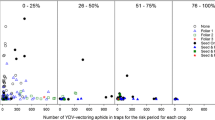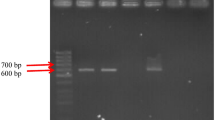Abstract
Sugarcane yellow leaf virus, the causal agent of yellow leaf, is transmitted from plant to plant by aphids. Understanding and evaluating the epidemic risks due to spread of yellow leaf by aphids is an important feature for sugarcane production. Four distinct sugarcane trials were set up with disease-free plants to study the relationship between spread of yellow leaf, the vector dynamics and environmental conditions that may favour yellow leaf epidemics. The study was performed by surveys of vector populations and determination of plant infections. Sugarcane cultivar SP71-6163, highly susceptible to yellow leaf, was analyzed spatially at different dates in all four trials and compared to commercial cultivars in two of the four trials. These surveys allowed us to identify a correlation between the aphid dynamics in the field and yellow leaf progress. Additionally, a negative correlation was found between rainfall during the first weeks after transferring sugarcane plants to the field and aphid dispersal within the field. This later result revealed an impact of rainfall on aphid invasion and subsequent plant infection by SCYLV. If aphids are the key factor for disease spread, plant response varied also according to cultivar resistance with high variation depending on rain conditions.






Similar content being viewed by others
References
Abu Ahmad, Y., Rassaby, L., Royer, M., Borg, Z., Braithwaite, K. S., Mirkov, T. E., et al. (2006a). Yellow leaf of sugarcane is caused by at least three different genotypes of Sugarcane yellow leaf virus, one of which predominates on the Island of Réunion. Archives of Virology, 151, 1355–1371.
Abu Ahmad, Y., Royer, M., Daugrois, J. H., Costet, L., Lett, J.-M., Victoria, J. I., et al. (2006b). Geographical distribution of four Sugarcane yellow leaf virus genotypes. Plant Disease, 90, 1156–1160.
Abu Ahmad, Y., Costet, L., Daugrois, J. H., Nibouche, S., Letourmy, P., Girard, J. C., et al. (2007). Variation in infection capacity and in virulence exists between genotypes of Sugarcane yellow leaf virus. Plant Disease, 91, 253–259.
Brown, J. K., & Bird, J. (1992). Whitefly-transmitted geminiviruses in the Americas and the Caribbean Basin: past and present. Plant Disease, 76, 220–225.
Cocu, N., Harrington, R., Rounsevell, M. D. A., Worner, S. P., & Hulle, M. (2005). Geographical location, climate and land use influences on the phenology and numbers of the aphid, Myzus persicae, in Europe and the EXAMINE project participants. Journal of Biogeography, 32, 615–632.
Comstock, J. C., Irey, M. S., Lockhart, B. E. L., & Wang, Z. K. (1998). Incidence of yellow leaf syndrome in CP cultivars based on polymerase chain reaction and serological techniques. Sugar Cane, 4, 21–24.
Comstock, J. C., Miller, J. D., Tai, P. Y. P., & Follis, J. E. (1999). Incidence of and resistance to sugarcane yellow leaf virus in Florida. Proceeding International Society of Sugar Cane Technologists, 23, 366–372.
D’Arcy, C. J., & Domier, L. L. (2005). Luteoviridae. In C. M. Fauquet, M. A. Mayo, J. Maniloff, U. Desselberger, & L. A. Ball (Eds.), Virus Taxonomy. VIIIth Report of the International Committee on Taxonomy of Viruses (pp. 891–900). New York: Elsevier Academic Press.
Daugrois, J. H., Jean-Baptiste, I., Lockhart, B. E. L., Irey, S., Chatenet, M., & Rott, P. (1999). First report of Sugarcane yellow leaf virus in the French West Indies. Plant Disease, 83, 588.
Döring, T. F., Kirchner, S. M., Kühne, S., & Saucke, H. (2004). Response of alate aphids to green targets on coloured backgrounds. Entomologia Experimentalis et Applicata, 113, 53–61.
Edon-Jock, C., Rott, P., Vaillant, J., Fernandez, E., Girard, J.-C., & Daugrois, J. H. (2007). Status of Sugarcane yellow leaf virus in commercial fields and risk assessment in Guadeloupe. Proceedings International Society of Sugar Cane Technologists, 26, 995–1004.
Edon-Jock, C., Daugrois, J. H., Jacquet, O., & Vaillant, J. (2009). Analysis of spatio-temporal spread of Sugarcane yellow leaf virus in a disease free plot using point process. In D. Gadoury, R. C. Seem, M. M. Moyer, & W. E. Fry (Eds.), Proceedings of the 10th International Epidemiology Workshop Geneva, NY (pp. 35–37). Ithaca: Cornell University.
Feldmann, P., Sapotille, J., Grédoire, P., & Rott, P. (1994). Micro-propagation of sugar cane. In C. Teisson (Ed.), In vitro Culture of Tropical Plants (pp. 15–17). Montpellier: La Librairie du Cirad.
Filipe, J. A. N., & Gibson, G. J. (1998). Studying and approximating spatio-temporal models for epidemic spread and control. Phil. Trans. Royal Society London B, 353, 2153–2162.
Gottwald, T. R., Gibson, G. J., Garnsey, S. M., & Irey, M. (1999). Examination of the effect of aphid vector population composition on the spatial dynamics of Citrus tristeza virus spread by stochastic modeling. Phytopathology, 89, 603–608.
Gray, S., & Gildow, F. E. (2003). Luteovirus-aphids interaction. Annual Review of Phytopathology, 41, 539–566.
Klueken, A. M., Hau, B., Ulber, B., & Poehling, H.-M. (2009). Forecasting migration of cereal aphids (Hemiptera: Aphididae) in autumn and spring. Journal of Applied Entomology, 133, 328–344.
Lehrer, A. T., Schenck, S., Yan, S.-L., & Komor, E. (2007). Movement of aphid-transmitted Sugarcane yellow leaf virus (SCYLV) within and between sugarcane plants. Plant Pathology, 56, 711–717.
Lockhart, B. E. L., & Cronjé, C. P. R. (2000). Yellow leaf syndrome. In P. Rott, R. A. Bailey, J. C. Comstock, B. J. Croft, & A. S. Saumtally (Eds.), A guide to sugarcane diseases (pp. 291–295). Montpellier: La Librairie du Cirad.
McAllister, C. D., Hoy, J. W., & Reagan, T. E. (2008). Temporal increase and spatial distribution of sugarcane yellow leaf and infestations of the aphid vector, Melanaphis sacchari. Plant Disease, 92, 607–615.
Milne, W. M., & Bishop, L. (1987). The role of predators and parasites in the natural regulation of lucerne aphids in Eastern Australia. Journal of Applied ecology, 24(3), 893–905.
Moonan, F., & Mirkov, T. E. (2002). Analyses of genotypic diversity among North, South, and Central American isolates of Sugarcane yellow leaf virus: Evidence for Colombian origins and for intraspecific spatial phylogenetic variation. Journal of Virology, 76(3), 1339–1348.
Pethybridge, S. J., & Madden, L. V. (2003). Analysis of spatiotemporal dynamics of virus spread in an Australian hop garden by stochastic modeling. Plant Disease, 87, 56–62.
Rassaby, L., Girard, J.-C., Letourmy, P., Chaume, J., Irey, M. S., Lockhart, B. E. L., et al. (2003). Impact of Sugarcane yellow leaf virus on sugarcane yield and juice quality in Réunion Island. European Journal of Plant Patholology, 109, 459–466.
Rassaby, L., Girard, J.-C., Lemaire, O., Costet, L., Irey, M. S., Kodja, H., et al. (2004). Spread of Sugarcane yellow leaf virus in sugarcane plants and fields on the Island of Réunion. Plant Pathology, 53, 117–125.
Rocha-Pena, M. A. (1995). Citrus tristeza virus and its aphid vector Toxoptera citmicida: Threats to citrus production in the Caribbean and Central and North America. Plant Disease, 79, 437–445.
Rott, P., Mirkov, T. E., Schenck, S., & Girard, J. C. (2008). Recent advances in research on Sugarcane yellow leaf virus, the causal agent of sugarcane yellow leaf. Sugar Cane International, 26, 18–27.
Schenck, S., Hu, J. S., & Lockhart, B. E. L. (1997). Use of a tissue blot immunoassay to determine the distribution of Sugarcane yellow leaf virus in Hawaii. Sugar cane, 4, 5–8.
Schenck, S., & Lehrer, A. T. (2000). Factors affecting the transmission of Sugarcane yellow leaf virus. Plant Disease, 84, 1085–1088.
Schenck, S. (2001). Sugarcane yellow leaf syndrome: history and current concepts. In G. P. Rao, R. E. Ford, M. Tosic, & D. S. Teakle (Eds.), Sugarcane pathology. Vol. II: Virus and Phytoplasma Diseases (pp. 25–35). Enfield: Science.
Schmidt, M. H., Lauer, A., Purtauf, T., Thies, C., Schaefer, M., & Tscharntke, T. (2003). Relative importance of predators and parasitoids for cereal aphid control. Proceedings of the Royal Society London B, 270, 1905–1909.
Thackray, D. J., Diggle, A. J., & Jones, R. A. C. (2009). BYDV PREDICTOR: a simulation to predict aphid arrival; epidemics of Barley yellow dwarf virus and yield losses in wheat crops in a Mediterranean-type environment. Plant Patholology, 58, 186–202.
Vega, J., Scagliusi, S. M. M., & Ulian, E. C. (1997). Sugarcane yellow leaf disease in Brazil: Evidence of association with a luteovirus. Plant Disease, 81, 21–26.
Viswanathan, R., Balamuralikrishnan, M., & Karuppaiah, P. (2008). Identification of three genotypes of Sugarcane yellow leaf virus causing yellow leaf disease from India and their molecular characterization. Virus Genes, 37, 368–379.
Zhou, G. H., Li, J. G., Xu, D. L., Shen, W. K., & Deng, H. H. (2006). Occurrence of Sugarcane yellow leaf virus in South China and its transmission by the sugarcane-colonizing aphid, Ceratovacuna lanigera. Scientia Agricultura Sinica, 39, 2023–2027.
Acknowledgments
This work was supported in part by the “Conseil Régional de Martinique”, the “Conseil Régional de Guadeloupe”, and the European Union. We would like to thank R. Boisne-Noc and S. Joseph for technical assistance.
Author information
Authors and Affiliations
Corresponding author
Rights and permissions
About this article
Cite this article
Daugrois, J.H., Edon-Jock, C., Bonoto, S. et al. Spread of Sugarcane yellow leaf virus in initially disease-free sugarcane is linked to rainfall and host resistance in the humid tropical environment of Guadeloupe. Eur J Plant Pathol 129, 71–80 (2011). https://doi.org/10.1007/s10658-010-9693-y
Accepted:
Published:
Issue Date:
DOI: https://doi.org/10.1007/s10658-010-9693-y




